
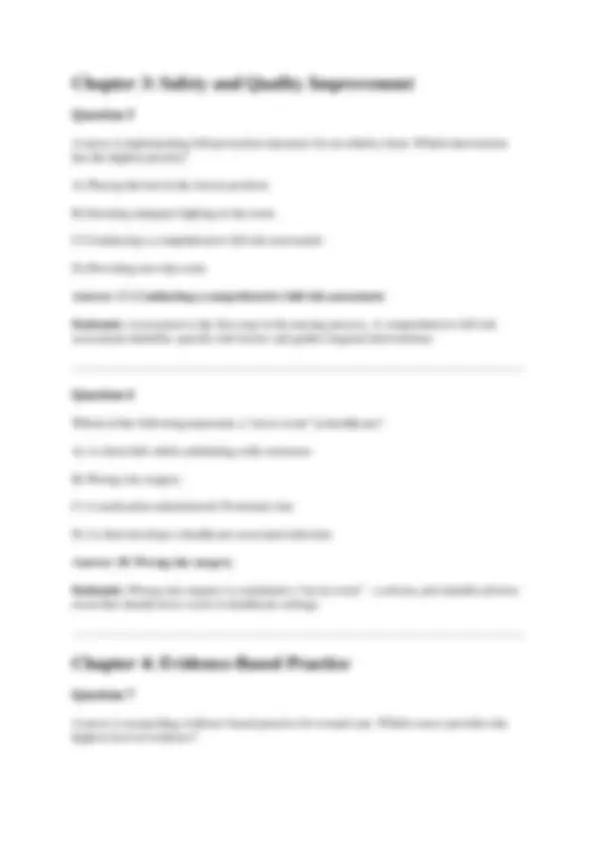
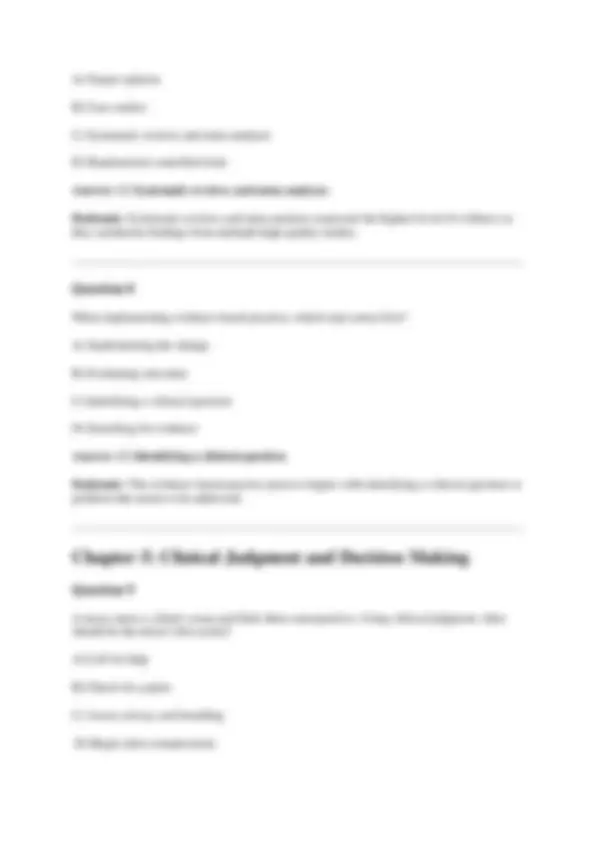
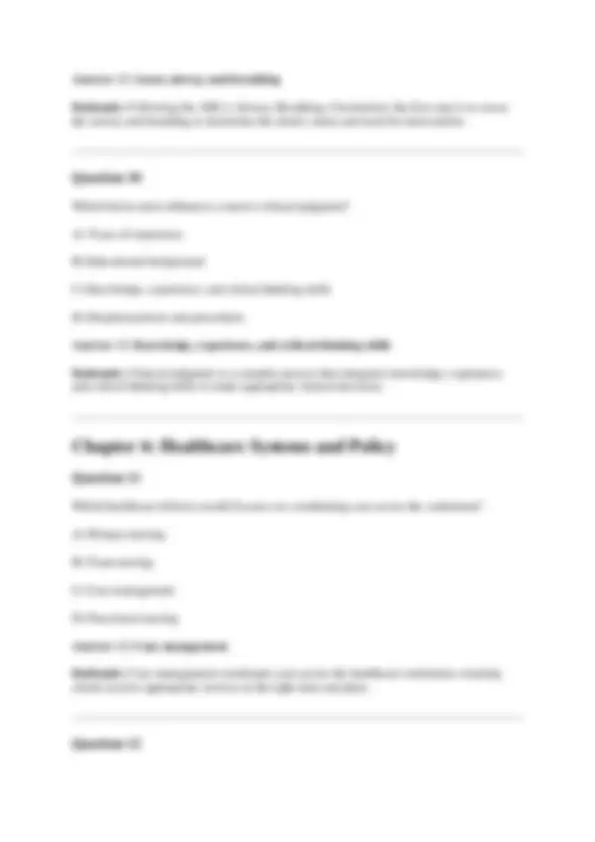
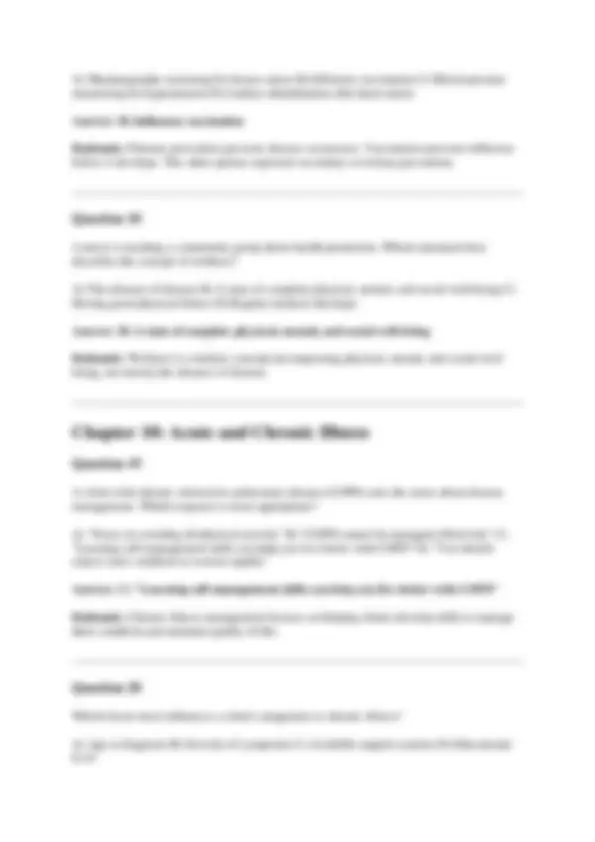
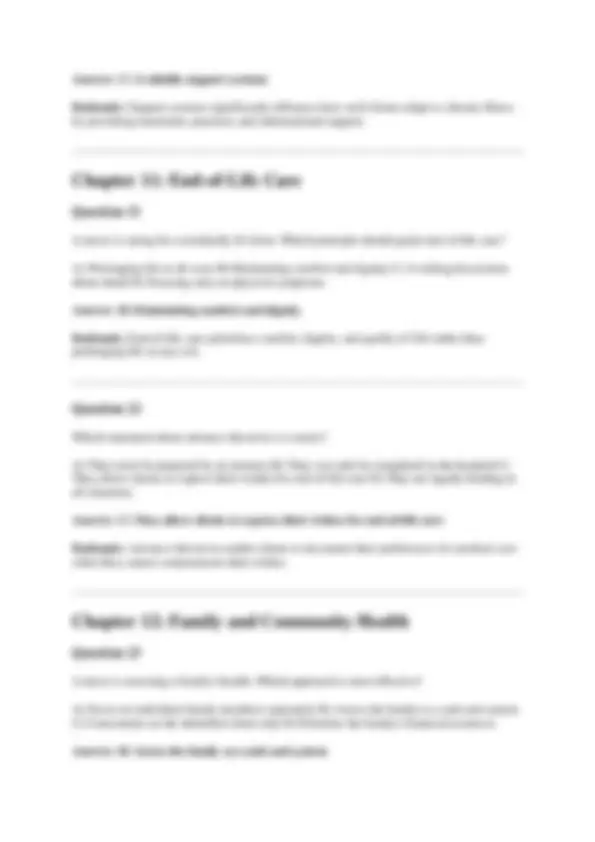
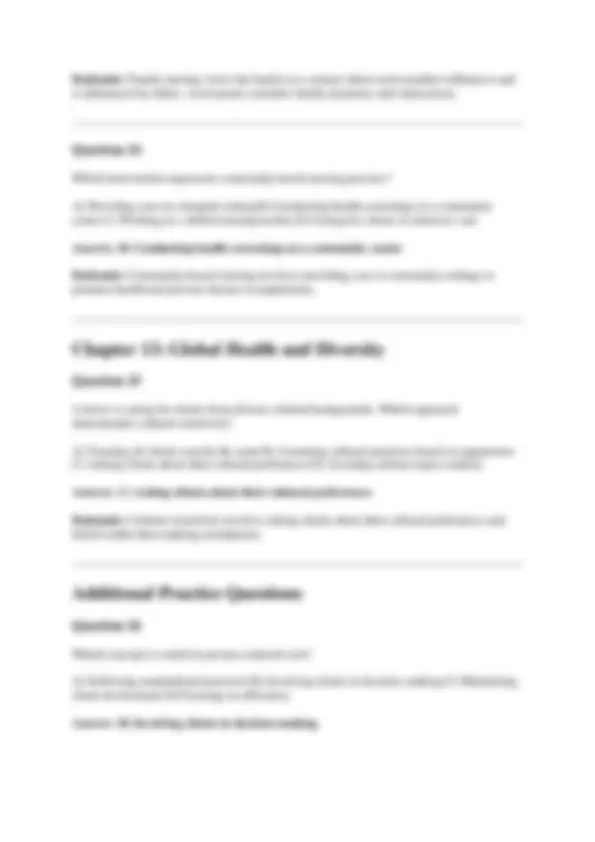


Study with the several resources on Docsity

Earn points by helping other students or get them with a premium plan


Prepare for your exams
Study with the several resources on Docsity

Earn points to download
Earn points by helping other students or get them with a premium plan
Community
Ask the community for help and clear up your study doubts
Discover the best universities in your country according to Docsity users
Free resources
Download our free guides on studying techniques, anxiety management strategies, and thesis advice from Docsity tutors
This test bank provides comprehensive coverage of nursing concepts essential for NCLEX, ATI, and HESI success. Use these questions to assess understanding and identify areas for further study.
Typology: Exams
1 / 12

This page cannot be seen from the preview
Don't miss anything!







A nurse is caring for a client who has been admitted with pneumonia. Which of the following best represents the concept of holistic nursing care? A) Focusing primarily on the client's respiratory symptoms B) Administering antibiotics as prescribed C) Addressing the client's physical, emotional, and spiritual needs D) Monitoring vital signs every 4 hours Answer: C) Addressing the client's physical, emotional, and spiritual needs Rationale: Holistic nursing care considers the whole person, including physical, emotional, spiritual, and social aspects. This approach recognizes that illness affects all dimensions of a person's well-being.
Which of the following actions demonstrates the nursing concept of advocacy? A) Administering medication as prescribed B) Speaking up for a client who is unable to communicate their needs C) Documenting nursing interventions accurately D) Following hospital policies and procedures
Answer: B) Speaking up for a client who is unable to communicate their needs Rationale: Advocacy involves supporting and protecting clients' rights and interests, especially when they cannot do so themselves. This is a fundamental nursing responsibility.
A nurse is communicating with a client who has hearing impairment. Which action should the nurse take? A) Speak louder than normal B) Face the client when speaking C) Use exaggerated lip movements D) Write everything down Answer: B) Face the client when speaking Rationale: Facing the client allows them to read lips and see facial expressions. Speaking louder can distort speech, and exaggerated movements make lip reading more difficult.
During shift report, a nurse receives information about a client's condition. Which element is most important for safe handoff communication? A) The client's medical history B) Current medications and recent changes C) The client's family information D) Insurance information Answer: B) Current medications and recent changes Rationale: Current medications and recent changes are critical for client safety and continuity of care. This information directly impacts immediate nursing interventions.
A) Expert opinion B) Case studies C) Systematic reviews and meta-analyses D) Randomized controlled trials Answer: C) Systematic reviews and meta-analyses Rationale: Systematic reviews and meta-analyses represent the highest level of evidence as they synthesize findings from multiple high-quality studies.
When implementing evidence-based practice, which step comes first? A) Implementing the change B) Evaluating outcomes C) Identifying a clinical question D) Searching for evidence Answer: C) Identifying a clinical question Rationale: The evidence-based practice process begins with identifying a clinical question or problem that needs to be addressed.
A nurse enters a client's room and finds them unresponsive. Using clinical judgment, what should be the nurse's first action? A) Call for help B) Check for a pulse C) Assess airway and breathing D) Begin chest compressions
Answer: C) Assess airway and breathing Rationale: Following the ABCs (Airway, Breathing, Circulation), the first step is to assess the airway and breathing to determine the client's status and need for intervention.
Which factor most influences a nurse's clinical judgment? A) Years of experience B) Educational background C) Knowledge, experience, and critical thinking skills D) Hospital policies and procedures Answer: C) Knowledge, experience, and critical thinking skills Rationale: Clinical judgment is a complex process that integrates knowledge, experience, and critical thinking skills to make appropriate clinical decisions.
Which healthcare delivery model focuses on coordinating care across the continuum? A) Primary nursing B) Team nursing C) Case management D) Functional nursing Answer: C) Case management Rationale: Case management coordinates care across the healthcare continuum, ensuring clients receive appropriate services at the right time and place.
D) All of the above Answer: D) All of the above Rationale: Effective delegation requires considering the task's complexity, the delegate's competence and availability, and ensuring it's within their scope of practice.
During the assessment phase of the nursing process, which type of data is most reliable? A) Subjective data from the client B) Objective data from physical examination C) Information from family members D) Data from previous hospitalizations Answer: B) Objective data from physical examination Rationale: Objective data is measurable, observable, and verifiable, making it more reliable than subjective data, though both are important for comprehensive assessment.
A nurse is developing a care plan for a client with diabetes. Which nursing diagnosis has the highest priority? A) Knowledge deficit related to diabetes management B) Risk for injury related to hypoglycemia C) Ineffective coping related to chronic illness D) Altered nutrition related to dietary restrictions Answer: B) Risk for injury related to hypoglycemia Rationale: Safety issues take priority. Hypoglycemia can cause immediate harm, including loss of consciousness and injury.
Which intervention represents primary prevention?
A) Mammography screening for breast cancer B) Influenza vaccination C) Blood pressure monitoring for hypertension D) Cardiac rehabilitation after heart attack Answer: B) Influenza vaccination Rationale: Primary prevention prevents disease occurrence. Vaccination prevents influenza before it develops. The other options represent secondary or tertiary prevention.
A nurse is teaching a community group about health promotion. Which statement best describes the concept of wellness? A) The absence of disease B) A state of complete physical, mental, and social well-being C) Having good physical fitness D) Regular medical checkups Answer: B) A state of complete physical, mental, and social well-being Rationale: Wellness is a holistic concept encompassing physical, mental, and social well- being, not merely the absence of disease.
A client with chronic obstructive pulmonary disease (COPD) asks the nurse about disease management. Which response is most appropriate? A) "Focus on avoiding all physical activity" B) "COPD cannot be managed effectively" C) "Learning self-management skills can help you live better with COPD" D) "You should expect your condition to worsen rapidly" Answer: C) "Learning self-management skills can help you live better with COPD" Rationale: Chronic illness management focuses on helping clients develop skills to manage their condition and maintain quality of life.
Which factor most influences a client's adaptation to chronic illness? A) Age at diagnosis B) Severity of symptoms C) Available support systems D) Educational level
Rationale: Family nursing views the family as a system where each member influences and is influenced by others. Assessment considers family dynamics and interactions.
Which intervention represents community-based nursing practice? A) Providing care in a hospital setting B) Conducting health screenings at a community center C) Working in a skilled nursing facility D) Caring for clients in intensive care Answer: B) Conducting health screenings at a community center Rationale: Community-based nursing involves providing care in community settings to promote health and prevent disease in populations.
A nurse is caring for clients from diverse cultural backgrounds. Which approach demonstrates cultural sensitivity? A) Treating all clients exactly the same B) Assuming cultural practices based on appearance C) Asking clients about their cultural preferences D) Avoiding cultural topics entirely Answer: C) Asking clients about their cultural preferences Rationale: Cultural sensitivity involves asking clients about their cultural preferences and beliefs rather than making assumptions.
Which concept is central to person-centered care? A) Following standardized protocols B) Involving clients in decision-making C) Minimizing client involvement D) Focusing on efficiency Answer: B) Involving clients in decision-making
Rationale: Person-centered care emphasizes client involvement in decisions about their care, respecting their preferences and values.
A nurse is implementing quality improvement measures. Which approach is most effective? A) Focusing on individual performance B) Using data to identify improvement opportunities C) Implementing changes without evaluation D) Maintaining current practices Answer: B) Using data to identify improvement opportunities Rationale: Quality improvement relies on data analysis to identify areas for improvement and measure the effectiveness of interventions.
Which principle guides ethical nursing practice? A) Beneficence (doing good) B) Non-maleficence (avoiding harm) C) Autonomy (respecting client choices) D) All of the above Answer: D) All of the above Rationale: Ethical nursing practice is guided by multiple principles including beneficence, non-maleficence, autonomy, and justice.
A nurse is teaching a client about medication adherence. Which strategy is most effective? A) Emphasizing the consequences of non-adherence B) Providing written instructions only C) Using teach-back method to verify understanding D) Assuming the client will follow instructions Answer: C) Using teach-back method to verify understanding Rationale: The teach-back method involves asking clients to repeat information in their own words, ensuring understanding and improving adherence.